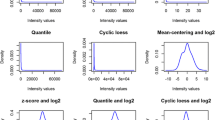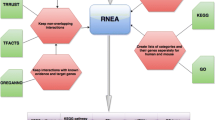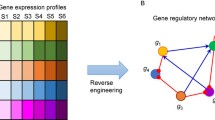Abstract
Building on the linear matrix inequality (LMI) formulation developed recently by Zavlanos et al. (Automatica: Special Issue Syst Biol 47(6):1113–1122, 2011), we present a theoretical framework and algorithms to derive a class of ordinary differential equation (ODE) models of gene regulatory networks using literature curated data and microarray data. The solution proposed by Zavlanos et al. (Automatica: Special Issue Syst Biol 47(6):1113–1122, 2011) requires that the microarray data be obtained as the outcome of a series of controlled experiments in which the network is perturbed by over-expressing one gene at a time. We note that this constraint may be relaxed for some applications and, in addition, demonstrate how the conservatism in these algorithms may be reduced by using the Perron–Frobenius diagonal dominance conditions as the stability constraints. Due to the LMI formulation, it follows that the bounded real lemma may easily be used to make use of additional information. We present case studies that illustrate how these algorithms can be used on datasets to derive ODE models of the underlying regulatory networks.



Similar content being viewed by others
References
Apkarian P, Becker G, Gahinet P, Kajiwara H (1996) LMI techniques in control engineering from theory to practice. In: Workshop notes—IEEE conference on decision and control, Kobe, Japan
Arnone M, Davidson E (1997) The hardwiring of development: organization and function of genomic regulatory systems. Development 124: 1851–1864
Bansal M, Belcastro V, Ambesi-Impiombato A, di Bernardo D (2007) How to infer gene networks from expression profiles. Mol Syst Biol 3(78). doi:10.1038/msb4100120
Bansal M, Gatta G, di Bernardo D (2006) Inference of gene regulatory networks and compound mode of action from time course gene expression profiles. Bioinformatics 22(7):815–822. doi:10.1093/bioinformatics/btl003. http://bioinformatics.oxfordjournals.org/content/22/7/815.full
Boyd S, Vandenberghe L (2003) Convex optimization. Cambridge University Press, Cambridge
Desoer C, Vidyasagar M (1975) Feedback systems: input-output properties. Academic Press, New York
DiBernardo D, Gardner TS, Collins JJ (2004) Robust identification of large scale genetic networks. In: Altman RB, Dunker AK, Hunter L, Jung TA, Klein TE (eds) Biocomputing 2004, proceedings of the Pacific symposium, Hawaii, USA, 6–10 January 2004, World Scientific, pp 486–497
Gardner TS, di Bernardo D, Lorenz D, Collins JJ (2003) Inferring genetic networks and identifying compound mode of action via expression profiling. Science 301:102–105
Horn R, Johnson C (1991) Topics in matrix analysis. Cambridge University Press, Cambridge
Mees A (1981) Achieving diagonal dominance. Syst Cont Lett 1(3):155–158
Penfold C, Wild D (2011) How to infer gene networks from expression profiles, revisited. Interface Focus Online 1(3):857–870. doi:10.1098/rsfs.2011.0053
Sastry S (1999) Nonlinear systems—analysis, stability and control. Springer, New York
Smoot M, Ono K, Ruscheinski J, Wang P, Ideker T (2011) Cytoscape 2.8: new features for data integration and network visualization. Bioinformatics 27(3):431–432. doi:10.1093/bioinformatics/btq675
Sontag E (2008) Network reconstruction based on steady-state data. Essays Biochem 45:161–176
Sontag E, Kiyatkin A, Kholodenko B (2004) Inferring dynamic architecture of cellular networks using time-series of gene expression, protein and metabolite data. BMC Bioinform 20(12):1877–1886
Tegner J, Yeung M, Hasty J, Collins JJ (2003) Reverse engineering gene networks: integrating genetic perturbations with dynamical modeling. PNAS 100(10):5944–5949. doi:10.1073/pnas.0933416100. http://www.pnas.org/content/100/10/5944.full
Theiffry D, Huerta A, Perez-Rueda E, Collado-Vides J (1998) From specific gene regulation to genomic networks: a global analysis of transcriptional regulation in Escherichia coli. Bioessays 20(5):433–440
Vidyasagar M (1993) Nonlinear systems analysis (second edition). Prentice-Hall, Englewood Cliffs, N.J
Yuan Y, Stan G, Warnick S, Goncalves J (2010) Robust dynamical network reconstruction. In: IEEE conference on decision and control. Atlanta, pp 180–185
Zavlanos M, Julius A, Boyd S, Pappas G (2011) Inferring stable genetic networks from steady-state data. Automatica: Special Issue Syst Biol 47(6):1113–1122
Acknowledgments
Data on malaria was collected at the laboratory of Prof. Sanjeeva Srivastava, Department of Biosciences and Bioengineering, Indian Institute of Technology Bombay, Mumbai, India (IIT Bombay). The malaria data was cured, in parts, by Prof. Sanjeeva Srivastava at IIT Bombay and by Dr. Jyoti Dixit, Prateek Singh, and Ankit Potla at Strand Life Sciences, Bangalore, India. This research is supported, in parts, by NSF CAREER Award 0845650, NSF CCF 0946601, NSF CCF 1117168, NSF CDI Award EECS 0835632, and by Strand Life Sciences, Bangalore, India.
Author information
Authors and Affiliations
Corresponding author
Rights and permissions
About this article
Cite this article
Kulkarni, V.V., Arastoo, R., Bhat, A. et al. Gene regulatory network modeling using literature curated and high throughput data. Syst Synth Biol 6, 69–77 (2012). https://doi.org/10.1007/s11693-012-9100-4
Received:
Accepted:
Published:
Issue Date:
DOI: https://doi.org/10.1007/s11693-012-9100-4




